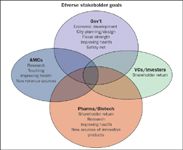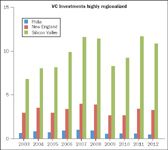Regional Trends in Bioinnovation Investment
California's Bay Area and the Boston/Cambridge nexus continue to dominate bioinnovation in the US. Pharm Exec looks at the factors contributing to the strategic dominance of these regions.
Bioinnovation has been a key driver of US economic development, with notable examples of success in California's Bay Area and the Boston/Cambridge nexus in Massachusetts. Over the past two decades, hundreds of thousands of jobs have been created through start-up companies and the large multinational anchor companies that attract ancillary support services, including venture capital. Today, many other jurisdictions—both in the United States and abroad—are seeking to replicate this productive ecosystem to support their own economic growth.
It is thus timely to ask: How have these regions become so successful in this space? What factors contribute to their dominant strategic position? What lessons can be applied to help other regions grow their bioinnovation assets? Noting the mutual benefits that pharma companies, academia and government obtain from these successful precedents, we identify the necessary foundations for a strong biotech ecosystem and explore a potential strategy blueprint using Philadelphia and the state of Pennsylvania as a case study.
The seeds of growth in bionnovation are rooted in four stakeholders: Academic medical and research centers (AMCs); biotech and pharma companies; investors, including VCs; and local, state and federal government institutions. Each of these stakeholders has dramatically different priorities and goals (see Figure 1).

Figure 1: Overlap of stakeholder missions
Maximizing the value of these relationships depends on identifying the areas where goals and mission align. While it may appear that the areas of overlap are small, they carry transformative potential. Breaking down silos that thwart the ecosystem of innovation is thus critical to success. For example, AMCs' mission is typically focused on excellence in research, teaching and patient care. But another key part of their mission is to translate basic medical breakthroughs, which are largely funded by public money through institutions like the National Institutes of Health (NIH), into improvements in medical care. These improvements are usually commercialized by the private sector, generating revenue growth and more jobs. Likewise, while VCs are focused primarily on return on investment to their limited partners, that investment remains a viable avenue to achieve substantial investment multiples. Since 2008, average multiples for VC-backed private biotech companies via M&A transactions have been increasing, while the biotechnology IPO market is starting to open up again. Ten IPOs were listed in the first five months of 2013, the largest number in nearly a decade.
While pharma and biotech firms must focus on shareholder return, there is often a paucity of internal assets to leverage this goal. So this, too, requires an effort to engage with other stakeholders through pre-competitive collaborations with AMCs that provide access to potential new pipeline assets. Finally, for governments, bioinnovation carries a multiplier effect by adding to the tax base and creating jobs through innovation-friendly urban infrastructure. The evidence shows that an interactive matrix supporting innovation has become mandatory for top-line growth in sectors vital to 21st century competitiveness.
The Cambridge Model
This success story begins with the universities and AMCs in the region, specifically MIT, Harvard University, Whitehead Institute, Tufts University, Boston University, University of Massachusetts, and their associated medical schools, medical centers and business schools. Among these institutions, MIT stands out with a vision of entrepreneurialism that was far ahead of its time. Specifically, MIT encouraged faculty to create start-ups and to collaborate with industry partners. Its Office of Technology Licensing has achieved some impressive metrics, with nearly $150 million in revenue, 16 start-ups and 199 US patents. More important, companies founded by MIT alumni employ 3.3 million people and generate revenues of approximately $2.2 billion annually. Some 6,900 MIT alumni firms are headquartered in Massachusetts and generate $164 billion in annual revenue within the state.
With MIT as the standard-bearer, neighboring institutions are moving toward relatively low-friction strategies that facilitate more bioinnovation. There is a critical mass of top-tier academic institutions in the Boston region that offer experience, talent, IP and vision that can turn invention into value. Resources derived from here are supporting critical research at a time when NIH funding is declining. Approximately 20% of MIT's overall research budget is derived from corporate partnerships, a figure far in excess of most peer institutions.
With this academic legacy as a stimulus, large multinational companies like Novartis and Sanofi, began locating their US research headquarters in Boston, Cambridge and surrounding suburbs. In addition, there are substantial home-grown successes, such as Biogen (now Biogen-Idec), Genzyme (now a wholly-owned subsidiary of Sanofi), Millennium (acquired by Takeda in 2008), Vertex, and Alkermes.
This influx of established companies and crop of new university-based start-ups requires vast amounts of capital. Of the 14 most active VCs worldwide in the biotech space, four are located in the Boston area, six in the Bay Area and two in New York; the remaining three are in Europe. The four VCs in the Boston Area—Third Rock Ventures, Atlas Ventures, MPM Capital (based in the Bay Area and in Boston) and SR One—have raised a total of $745M to invest in mainly local ventures. Interestingly, however, of the top ten VC deals in 2012 in terms of dollar value, only one company, Bluebird Bio, was in the Boston area, while seven were in California, reinforcing the regional bias inherent in VC investing. This is important, because once a region dominates on access to capital, it creates a positive feedback loop where dollars continue to flow into ventures led by known managers with strong track records of facilitating lucrative VC exits.
A final element in the Cambridge story is proactive government. The state of Massachusetts, through its fiscal policies and life sciences initiatives, has created a positive business environment for the industry. An example is the 10-year, $1-billion Life Sciences Initiative enacted in 2008. As part of this initiative, the Massachusetts Life Sciences Center (MLSC) was created to implement the program. Its goals are to strengthen the state's role as the international leader in life sciences, create high-skill/high-paying jobs, attract investment dollars and support innovation and entrepreneurship.
The MLSC is structured around a diverse Board of Directors and Scientific Advisory Board charged with allocating a $500 million capital fund, a $250 million tax incentive program and a $250 million investment fund. As of February 2013, $359 million has been committed and used to leverage $1.03 billion in matching investments. Funds provide direct support for research, new investigators, recruitment of top talent to universities, industry/academic research collaborations, start-up capital to early-stage companies, and capital investment for infrastructure support. MLSC has made 77 awards totaling $56 million in tax relief to companies, who have pledged, in turn, to add 2,800 new jobs to the existing 80,000 life sciences jobs in the state. Outside the MLSC program, the state and local authorities have invested in a land use policy that includes new, open corporate space design, common green space, high-quality public transport, mixed residential/corporate neighborhoods, and use of the Boston area waterfront that fosters business collaboration.
Can Cambridge Be Cloned?
Despite the fact that bioinnovation has flourished in Massachusetts and California, other parts of the country continue to struggle. This raises the question: can their success be replicated? To provide an answer, we examine how various engagement strategies play out among each of the four stakeholders that nurture biopharma innovation.
» Educating AMCs. Researchers, clinician-investigators and administrators are the source of all university-based innovation. Understanding this fundamental concept is the first step toward change; in fact, it begins with mobilizing the strength of this "grassroots" network. One way to do it is to encourage researchers to learn more about basic operational realities involved in translational research, including cost, timelines, and regulatory considerations; the process of due diligence to determine the value of an invention or business concept; intellectual property; and sources of funding. Educating this group toward a basic level of business acumen is critically important, but this is seldom done in most AMCs.
Investigators should be aware of where funding in today's environment is coming from, and to the extent possible, align their research interests with funders' goals and interests. They should get external business advice as "quality control" for their strategy, starting with the real world value of their innovation. Most importantly, researchers must be their own advocates: they must talk often and openly with other stakeholders to monitor the process and identify improvements.
One priority often overlooked is to detect and eliminate barriers to cooperation. Often, these exist to protect IP or to promote ethical behavior. This requires a revisit of long-standing policies like IP ownership, equity ownership by founders, reach-through rights and conflicts of interest. An extension of this point is developing rigorous standards for fiscal responsibility while being reasonable and creative in negotiating terms with licensees, start-ups and industry collaborators. Too often these institutions insist upon prohibitive financial terms and structures that are non-starters for a partnership. Institutions with traditional, non-entrepreneurial cultures should look at peer institutions that have established bioinnovation-enabling policies without compromising their academic missions; examples include MIT, University of California at San Francisco, Duke University, Stanford and the Cleveland Clinic.
Faculty should be recognized and rewarded for achievements related to entrepreneurship, in the same way that they are for securing grants or publishing in peer-reviewed journals. Equally important is striking a balance between basic research and translational work—do not forsake the former for the latter. Finally, AMCs and universities must provide resources for their entrepreneurs, including infrastructure to support basic and clinical research, regulatory and business support, and funding in the form of grants or, more interestingly, venture funding in exchange for an equity position.
» Pharma, biotech and other industrial partners. Private industry is increasingly interested in working with other stakeholders. More than 350 life sciences academic-industry deals/partnerships were agreed in 2012, predominantly in cancer (15%), infectious disease (14%), diagnostics (15%) and neurology (12%). The top academic institutions in terms of deal flow included Harvard and the University of Texas, with seven each; University College of London and University of California system, with six apiece; and Broad Institute (MIT and Harvard), with four. Nearly all of these deals were discovery-stage, platform-based collaborations.
Pharma and biotech companies also engaged in a substantial amount of M&A activity, with 27 acquisitions in 2012. Only six of the acquired companies were at the preclinical stage, four in Phase I and the remainder in Phase II or higher. Similarly, total licensing deals continue to decline from 2010 levels, with the vast majority in the discovery or post-Phase II space. This leaves a gap in partnership activity and corporate funding for innovative technologies in the critical pre-proof-of-concept area. It reflects the increasingly low-risk tolerance of potential partners. Very early stage deals are cheap and large payments are back-ended, thus allowing partners exclusive access to a potentially valuable platform for very little upfront investment. Post-Phase II deals are sufficiently de-risked and provide an opportunity to add a near-term clinical asset to often dwindling pipelines. Everything in between is too risky and too expensive. In addition, the most active therapeutic areas in terms of deal volume—oncology and infectious disease—represent areas where regulatory reforms, such as breakthrough designation, make the development timelines more attractive than in other areas.
In parallel, VC arms of pharma and biotech companies are becoming more active in earlier-stage investments that often fall outside the scope of the parent company's interest and mandate. In fact, of the 14 most active VC firms in life sciences in 2012, five were venture arms of pharmaceutical companies: Novo Nordisk, Novartis, Pfizer, SR One and Shire, which together represent a total of more than $1.1 billion in potential investment dollars.
While it is difficult to imagine pharma and biotech companies altering their risk-tolerance profiles on new deals given shareholder pressures, a reasonable avenue to maintain early-stage investment for start-ups and access for their partners would be for pharma and biotech companies to shift a portion of their substantial cash reserves into venture investment vehicles. These investments are most typically part of a syndicate of other VCs that further reduces risk but preserves potential ROI and access to early-stage, truly innovative technologies.
» Local and state government agencies. Many analyses indicate that to be competitive in the bioinnovation landscape, governments must build infrastructure, offer tax incentives for businesses to relocate and add jobs, and fund grants and other direct investments in research. Yet with slow recovery from the 2008 financial crisis continuing, local and state government leaders are under considerable pressure to maintain budget neutrality.
Given the Massachusetts example, creative government intervention is a powerful tool. Moreover, public support goes a long way to bridge the gap between discovery and proof-of-concept that is currently hobbling much of the true innovation in the life sciences.
» VC funding. The final piece of the life sciences ecosystem puzzle is equity financing, provided typically by a robust VC community. At least three important trends have emerged over the past five years. First, VCs and their investments are highly regional (see Figure 2). Second, with a few important exceptions, such as Third Rock Ventures, VCs are not investing in the translational research phase, but rather the peri-proof-of-concept phase. Third, relatively few new start-ups are being funded; the bulk of VC investments are going to follow-on rounds in existing portfolio companies.

Figure 2: Regional trends in VC investment 2003-2012
Moreover, in 2012, the amount of VC investment in young, innovative life sciences companies fell to its lowest level in nearly 10 years. This holds true both in the United States, where funding was 4% lower than 2011, and in Europe, which saw a substantial drop of 31%. In addition, this cash is spread over fewer deals, 156 in 2011 in the United States, and highly concentrated into a handful of biotech hubs. This reflects the zero-risk tolerance of many VCs and their limited partners, the overall downturn of the investment markets since 2008, a paucity of quality management teams for start-ups, and, until very recently, inability to access public markets for exit. With biotech IPOs at their highest level in years, strong data supporting ROI, and the overall stock market at an all-time high, perhaps we will see greater risk tolerance among VCs and a return to their roots of funding novel research and new innovation. If so, this will be vital to extending the locus of a strong bioinnovation ecosystem.
Philadelphia: The Next Cambridge?
The Cambridge example shows the necessity of engaging and incentivizing all stakeholders to create and maintain a successful and thriving bioinnovation ecosystem. Philadephia and the state of Pennsylvania is as an interesting counterexample, with similar parameters to Cambridge and Massachusetts. Philadelphia has four top-tier AMCs and universities (University of Pennsylvania, Temple, Thomas Jefferson and Drexel); the second-highest level of NIH funding by institution (Penn); many multinational pharmaceutical companies and large biotechnology companies; and a small concentration of early-stage biotech and life sciences companies. The state's second-biggest city, Pittsburgh, is home to the University of Pittsburgh School of Medicine, a top-ten medical school and ranked sixth for NIH funding, and Carnegie Mellon, a leading engineering school.
Despite this, the city and state is not considered a vibrant hub of bioinnovation. Why? Our premise is that the four key stakeholders have not yet been fully engaged in this goal.
AMCs in PA don't make realizing the value of their innovations a strategic imperative; none of the top ten AMCs most active in spin-out formation are in PA, despite the fact that Penn ranked third in European and sixth in US patents issued to it in the eight-year period ending in March 2013. In contrast, MIT ranks far below Penn in the number of patents issued, but was the second-most active, behind the UCAL system, in spinning out new life sciences companies.
In addition, there is a limited amount of VC funding available. While many pharma and biotech partners make their homes in the Philadelphia area, their deals in the last several years are focused geographically in Cambridge and Silicon Valley. Gov. Tom Corbett has spoken openly about making life sciences investment a priority in PA, but there are few tangible results to date. The much discussed "D2PA" program—discovered in PA, developed in PA—allocates just $10 million in the current state budget to invest in new companies. The Life Sciences Greenhouse and Ben Franklin groups, funded by the state to invest in new technologies across all industries, have invested only $23 million into 33 seed and 23 pre-seed companies, and $17 million into 40 companies, respectively, since 2003. Gov. Corbett has put forward several tax incentive plans that will take effect over the next several years and has convened a panel of business leaders to discuss approaches to building and supporting a bioinnovation ecosystem in PA. Taken together, however, these initiatives pale in comparison to the strategies taken by states with highly successful life sciences hubs. If bioinnovation is going to succeed in unleashing new growth in PA, more must be done to incentivize each of the four stakeholders to make investments—and take risks.

Amanda Christini, MD, is Director of Strategic Initiatives at Penn Medicine Center for Healthcare Innovation. She can be reached at amanda.christini@uphs.upenn.edu. Ken Kaitin is Professor and Director of the Tufts Center for the Study of Drug Development, Tufts University School of Medicine. He can be reached at Kenneth.kaitin@tufts.edu.
The Misinformation Maze: Navigating Public Health in the Digital Age
March 11th 2025Jennifer Butler, chief commercial officer of Pleio, discusses misinformation's threat to public health, where patients are turning for trustworthy health information, the industry's pivot to peer-to-patient strategies to educate patients, and more.
Navigating Distrust: Pharma in the Age of Social Media
February 18th 2025Ian Baer, Founder and CEO of Sooth, discusses how the growing distrust in social media will impact industry marketing strategies and the relationships between pharmaceutical companies and the patients they aim to serve. He also explains dark social, how to combat misinformation, closing the trust gap, and more.
